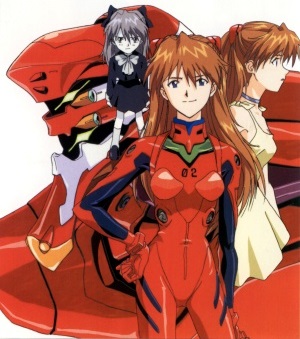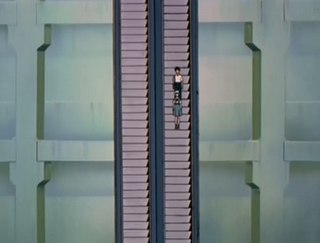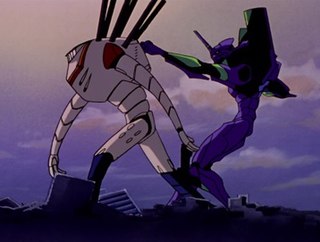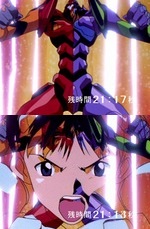
The Angels are fictional entities from the anime television series Neon Genesis Evangelion, which was produced by Gainax studio and directed by Hideaki Anno. The Angels also appear in the manga adaptation of the same name, which was illustrated by Yoshiyuki Sadamoto.

Asuka Langley Soryu is a fictional character from the Neon Genesis Evangelion franchise created by Gainax. She first appears in the original anime series, and also appears in the franchise's animated feature films and related media, including video games, the Rebuild of Evangelion films, and the manga adaptation by Yoshiyuki Sadamoto. In Japanese, Yūko Miyamura voices Asuka in all her animated appearances and merchandise. In English, Tiffany Grant voices her in the ADV Films dub and Stephanie McKeon voices her in the Netflix dub.

Misato Katsuragi is a fictional character from the Gainax-created media franchise Neon Genesis Evangelion. In the eponymous anime television series, Misato is head of the operations department of the special agency Nerv, and is in charge of directing and devising war strategies needed to defeat mysterious beings named Angels. Due to childhood emotional traumas, she developed a frivolous, exuberant character and a disordered lifestyle. The character also appears in the franchise's animated feature films and related media, including video games, the original net animation Petit Eva: Evangelion@School, the Rebuild of Evangelion films, and the manga adaptation by Yoshiyuki Sadamoto.

"Angel Attack" is the first episode of the anime series Neon Genesis Evangelion, created by Gainax. The episode was written by the series director Hideaki Anno and directed by Kazuya Tsurumaki. It was originally aired on TV Tokyo on October 4, 1995. The series is mostly set in the futuristic, fortified city Tokyo-3, fifteen years after a worldwide cataclysm named Second Impact. The protagonist is Shinji Ikari, a teenage boy whose father Gendo has recruited him to the organization Nerv to pilot a giant bio-machine mecha named Evangelion to combat beings called Angels. In the episode, Tokyo-3 is attacked by the Angel Sachiel, who fights the United Nations Army and the JSSDF. Gendo summons Shinji for the first time and Shinji reluctantly agrees to pilot the mecha.

"The Beast", known by the Japanese title "Unfamiliar Ceilings", is the second episode of the anime Neon Genesis Evangelion, created by Gainax. The episode was written by the series director Hideaki Anno and Yōji Enokido and directed by Kazuya Tsurumaki. It aired originally on TV Tokyo on October 11, 1995.

"Rei I", also known by the Japanese title "Rei, Beyond the Heart", is the fifth episode of the anime Neon Genesis Evangelion, which was created by Gainax. "Rei I" was written by Hideaki Anno and Akio Satsukawa, and directed by Keiichi Sugiyama. It was first broadcast on TV Tokyo on November 1, 1995. The series is set fifteen years after a worldwide cataclysm named Second Impact, mostly in the futuristic, fortified city called Tokyo-3. The episode's protagonist is Shinji Ikari, a teenage boy who is recruited by his father Gendo into the organization Nerv to pilot a giant bio-machine mecha named Evangelion to combat certain beings called Angels. In the episode, Shinji tries, but fails, to connect with Rei Ayanami, a fellow pilot, who is close to his distant and cold father Gendo.

"Rei II", also known by the Japanese title "Showdown in Tokyo-3", is the sixth episode of the anime Neon Genesis Evangelion, which was created by Gainax. "Rei II" was written by Hideaki Anno and Akio Satsukawa and directed by Hiroyuki Ishido. The series is set fifteen years after a worldwide cataclysm named Second Impact, and is mostly set in the futuristic, fortified fictional city of Tokyo-3. The episode's protagonist is teenage boy Shinji Ikari, who is recruited by his father Gendo to the organization Nerv to pilot a bio-machine mecha named Evangelion against beings called Angels. In the episode, Shinji must annihilate the fifth Angel Ramiel, who is able to destroy every enemy in its vicinity with an accelerated particles cannon. A plan called Operation Yashima is worked out, which involves Shinji shooting Ramiel from a distance with a Positron Rifle.

"A Human Work", also known by the Japanese title "The Works of Man", is the seventh episode of the Japanese anime television series Neon Genesis Evangelion, which was created by Gainax. The episode, written by Hideaki Anno and Yoji Enokido and directed by Keiichi Sugiyama, was first broadcast on TV Tokyo on November 15, 1995. The series is set fifteen years after a worldwide cataclysm named Second Impact, and is mostly set in the futuristic, fortified city Tokyo-3. The series' protagonist is Shinji Ikari, a teenage boy who is recruited by his father Gendo to the organization Nerv to pilot a giant bio-mechanical mecha named Evangelion into combat with beings called Angels. In the episode, a rival organization of Nerv builds Jet Alone, a prototype giant robot with an onboard nuclear reactor as an alternative to the Evangelions. During the first public test of Jet Alone, it goes out of control and marches toward a nearby city with its reactor close to a meltdown. Shinji keeps the robot at bay in his Evangelion while Nerv's Major Misato Katsuragi gets inside Jet Alone and shuts down the reactor.

"Asuka Strikes!" is the eighth episode of the Japanese anime television series Neon Genesis Evangelion, which was created by Gainax. The episode, written by Hideaki Anno and Yoji Enokido and directed by Kazuya Tsurumaki, was first broadcast on TV Tokyo on November 22, 1995. The series is set fifteen years after a worldwide cataclysm and is mostly set in the futuristic, fortified city Tokyo-3. The series' protagonist is Shinji Ikari, a teenage boy who is recruited by his father Gendo to the organization Nerv to pilot a gigantic, bio-mechanical mecha named Evangelion into combat with beings called Angels. During the episode, Asuka Langley Soryu, a girl who is designated as the pilot of Evangelion Unit-02, is introduced; after the attack of Gaghiel, the sixth Angel, Asuka cooperates with Shinji aboard the Eva-02 to defeat the enemy.

"Magmadiver" is the tenth episode of the Japanese anime television series Neon Genesis Evangelion, which was created by Gainax. The episode, written by Hideaki Anno and Akio Satsukawa and directed by Tsuyoshi Kaga and Kiroyuki Ishido, was first broadcast on TV Tokyo on December 6, 1995. The series is set fifteen years after a worldwide cataclysm and is mostly set in the futuristic, fortified city Tokyo-3. The series' protagonist is Shinji Ikari, a teenage boy who is recruited by his father Gendo to the special military organization Nerv to pilot a gigantic, bio-mechanical mecha named Evangelion into combat with beings called Angels. During the episode, Asuka Langley Soryu, a girl who is designated as the pilot of Evangelion Unit-02, tries to capture the eighth Angel, Sandalphon, found in the magma chamber of a Volcano in a dormant state.

"The Day Tokyo-3 Stood Still" is the eleventh episode of the Japanese anime television series Neon Genesis Evangelion, which was created by Gainax. The episode, written by Hideaki Anno and Yoji Enokido and directed by Tetsuya Watanabe, was first broadcast on TV Tokyo on December 13, 1995. The series is set fifteen years after a worldwide cataclysm named Second Impact and is mostly set in the futuristic, fortified city of Tokyo-3. The series' protagonist is Shinji Ikari, a teenage boy who is recruited by his father Gendo to the special military organization Nerv to pilot a gigantic, bio-mechanical mecha named Evangelion into combat with beings called Angels. In this episode, the special agency Nerv suddenly experiences a blackout due to sabotage by unidentified third parties. The three Evangelion mecha pilots, Shinji, Rei Ayanami and Asuka Langley Soryu, join forces to take down the ninth Angel, Matarael.

"Splitting of the Breast" is the sixteenth episode of the Japanese anime television series Neon Genesis Evangelion, which was created by Gainax. The episode was written by Hideaki Anno and Hiroshi Yamaguchi, and directed by Kazuya Tsurumaki. The series' protagonist is Shinji Ikari, a teenage boy whose father Gendo recruits him to the special military organization Nerv to pilot a gigantic, bio-mechanical mecha named Evangelion into combat with beings called Angels. In the episode, Shinji is absorbed into an Angel called Leliel in a space of imaginary numbers called Dirac sea. Shinji has a vision in which he sees another self as a child and discusses his lifestyle.

"Ambivalence" is the eighteenth episode of the Japanese anime television series Neon Genesis Evangelion, which was created by Gainax. Hideaki Anno and Shinji Higuchi wrote the episode, which animator Tensai Okamura directed. The series' protagonist is Shinji Ikari, a teenage boy whose father Gendo recruited him to the special military organization Nerv to pilot a gigantic, bio-mechanical mecha named Evangelion into combat with beings called Angels. In the course of the episode, new pilot Toji Suzuhara get into Eva-03. During the activation experiment, however, Eva-03 goes out of control, possessed by the Angel Bardiel. Shinji, aboard his Eva-01, refuses to fight against 03, coming into conflict with his father.

"He was aware that he was still a child" is the twenty-first episode of the Japanese anime television series Neon Genesis Evangelion, created by Gainax. Hideaki Anno and Akio Satsukawa wrote the episode, which animator Hiroyuki Ishido directed. The series' protagonist is Shinji Ikari, a teenage boy whose father Gendo recruited him to the special military organization Nerv to pilot a gigantic, bio-mechanical mecha named Evangelion into combat with beings called Angels. In the course of the episode, Kozo Fuyutsuki, deputy commander of Nerv, is kidnapped by a secret organization called Seele, which questions him about his past and how he met Gendo. Fuyutsuki traces his youth and his meeting with Yui Ikari, a young scientist with whom he falls in love. Ryoji Kaji, a member of Nerv, meanwhile rescues Fuyutsuki, and is killed by Seele.

"She said, 'Don't make others suffer for your personal hatred.'" is the twelfth episode of the Japanese anime television series Neon Genesis Evangelion, which was created by Gainax. The episode was first broadcast on TV Tokyo on December 20, 1995. It was written by Hideaki Anno and Akio Satsukwa and directed by Hiroyuki Ishido. The series is set fifteen years after a worldwide cataclysm known as Second Impact and is mostly set in the futuristic city of Tokyo-3. The series' protagonist is Shinji Ikari, a teenage boy who is recruited by his father Gendo to the special military organization Nerv to pilot a bio-mechanical mecha named Evangelion into combat with beings called Angels. During the episode, Nerv's Major Misato Katsuragi recalls her past as a survivor of the Second Impact, while a new, large-sized Angel called Sahaquiel threatens to destroy the entire Nerv headquarters.

"A Transfer", known by the Japanese title "The Silent Phone", is the third episode of the anime Neon Genesis Evangelion, created by Gainax. Series director Hideaki Anno and writer Akio Satsukawa wrote the episode, directed by Hiroyuki Ishido. It aired originally on TV Tokyo on October 18, 1995. The series is set fifteen years after a worldwide cataclysm named Second Impact, particularly in the futuristic fortified city of Tokyo-3. The protagonist is Shinji Ikari, a teenage boy whose father, Gendo, recruited him to the organization Nerv to pilot a giant bio-machine mecha named Evangelion into combat with beings called Angels. In the episode, Shinji begins attending his new school in Tokyo-3 and has a difficult time dealing with the fame of being an Evangelion pilot. His classmate Toji Suzuhara, whose little sister was injured in Shinji's fight against the Angel Sachiel shown in the previous episode, is angry at him; a new Angel named Shamshel appears, and Shinji must once again pilot Eva-01 to defeat it.

"Those women longed for the touch of others' lips, and thus invited their kisses" is the fifteenth episode of the Japanese anime television series Neon Genesis Evangelion, which was created by Gainax. The episode, written by Hideaki Anno and Akio Satsukawa and directed by Naoyasu Habu, was first broadcast on TV Tokyo on January 10, 1996. The series is set fifteen years after a worldwide cataclysm known as Second Impact and is mostly set in the futuristic, fortified city of Tokyo-3. The series' protagonist is Shinji Ikari, a teenage boy who is recruited by his father Gendo into the special military organization Nerv to pilot a gigantic, bio-mechanical mecha named Evangelion into combat with beings called Angels.

"Fourth Child" is the seventeenth episode of the Japanese anime television series Neon Genesis Evangelion. Hideaki Anno and Shinji Higuchi wrote the episode, while Minoru Ohara worked as director. The series' protagonist is Shinji Ikari, a teenage boy whose father Gendo recruited him to the special military organization Nerv to pilot a gigantic, bio-mechanical mecha named Evangelion into combat with Angels. In the episode, mecha Eva-04 and Nerv's Second American Division disappear, while Toji Suzuhara is selected as the pilot of Eva-03. Hikari Horaki, class leader of Toji and Shinji's class, asks Toji to prepare something for him to eat.

"Weaving a Story 2: oral stage" is the twentieth episode of the Japanese anime television series Neon Genesis Evangelion, which was created by Gainax. Hideaki Anno wrote the episode, which animator Masahiko Otsuka directed. The series' protagonist is Shinji Ikari, a teenage boy whose father Gendo recruited him to the special military organization Nerv to pilot a gigantic, bio-mechanical mecha named Evangelion into combat with beings called Angels. In the course of the episode, Eva-01 absorbs Shinji inside its cockpit. Trapped inside the mecha devoid of a physical form, Shinji reflects on his life and past battles; meanwhile, Nerv implements a plan to rescue Shinji.

"Hedgehog's Dilemma", also known by the Japanese title "Rain, After Running Away", is the fourth episode of the anime Neon Genesis Evangelion, which was created by Gainax. The episode, written by Akio Satsukawa and directed by Tsuyoshi Kaga, was first broadcast on TV Tokyo on October 25, 1995. The series is set fifteen years after a worldwide cataclysm named Second Impact, and is mostly set in the futuristic, fortified city Tokyo-3. The episode's protagonist is Shinji Ikari, a teenage boy who is recruited by his father Gendo to the organization Nerv to pilot a giant bio-machine mecha named Evangelion into combat with beings called Angels. In the episode, Shinji is overcome by the stress of being an Evangelion pilot and runs away from home. After wandering around Tokyo-3, he must choose between quitting and staying at Nerv.























